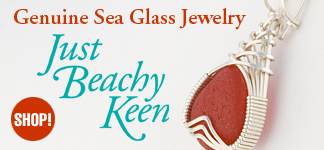The Sea Glass Shard of the Month: September 2014
Sea Glass Bottle Top
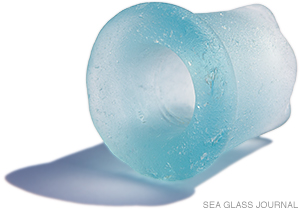
See MORE IMAGES
Sea Glass Specifications:
Color: Soft Blue
Max Height: 30.2 mm (1.19")
Max Diameter: 31.8 mm (1.25")
Weight: 26.1 grams (0.92 oz)
Estimated Age: At least 100 years old
September's featured sea glass specimen is a soft blue bottle top, more specifically the lip with part of its neck partially intact. We will take a look at both the color and lip attributes of the featured piece and employ what is known about the history of bottle making to assist in determining its original use as well as estimating its age.
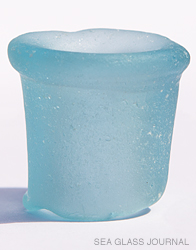
Photo 1 - Observe the uneven form of the beaded rim as it traverses around the top of the lip.
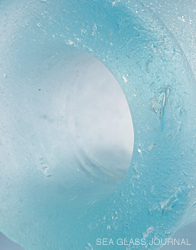
Photo 2 - Concentric rings appear on the inside bore (opening) indicating that a finishing tool was used to complete the lip.
Facts of Interest
The term "finish" originates with the mouth-blown bottle production process where the last step in completing a finished bottle was to "finish the lip." Conversely, with semi-automatic and fully automatic bottle machines, the lip or finish was (and still is) the first forming step in the bottle making process.[3]
The technique of finishing the lip was also referred to as "goffering" in the 1800s.
The crown cap finish that we all recognize on many bottle tops today was patented in 1982 by William Painter of Baltimore.
Color
The color of a sea glass shard is usually the first characteristic that a beachcomber will notice when finding a piece of sea glass. The soft blue color of this piece is usually due to the presence of copper in the glass batch. Copper impurities found within the sand used to produce the glass could create the light blue shade, but it normally was created by using copper oxide as a colorant.[1]
While color is only weakly related to the function of a glass object as different colors can be found in the myriad of bottle types, there were some trends in color use as related to the utility of a particular bottle that can be noted on at least a generalized level. It can also be noted that there were some colors that were rarely used for a particular bottle type.[2]
 |
...color is only weakly related to the function of a glass object... |
 |
The soft blue (light aqua) color of this shard was most often used in food containers as well as patent medicine and drug bottles from the 19th and early 20th Centuries. Colorless (clear) glass largely replaced aqua as the desired color after the 1920s by bottle users wishing their product to be visible to the consumer.[2] One well-known exception to this is the aqua colored Ball mason jars.
At this point a general assumption will be that the shard came from a medicine or food container dating no later than the early 20th Century. Next, an analysis of the lip design will be employed to assist in the identification of the sea glass specimen.
Finish
One of the most effective diagnostics used by bottle collectors to identify the age and use of a particular bottle is to look at the finish, also known as the lip. The term "finish" originates with the mouth-blown bottle production process where the last step in completing a finished bottle was to "finish the lip"[3] after the blow pipe was removed from the newly formed bottle. If the method of finishing can be determined it can indicate a general time in history that the bottle was manufactured. Identifying the lip design can also suggest the bottle function as some designs were more common for one type of bottle over another.
The lip style appears to be a hybrid between a flared-out lip and a bead lip. Flared lips were often used in medicine bottles and the bead style were common in food containers. Due to the small bore hole of this bottle and the flare design making a cork stopper the probable type of closure we will assume that our sea glass gem was a type of medicinal dispensing bottle rather than a pickle or pepper sauce container.
A few characteristics of this lip indicate a mouth-blown process where the lip was completed after the base and neck were formed. This is compared to a machine made bottle process that developed in the early 1900s. The lack of symmetry of the bore hole (opening) as well as the uneven form of the beaded rim as it traverses around the top of the lip (photo #1 on left) are indicative of a pre-machine made bottle. This type of lip forming employed an iron caliper type finishing tool (aka "lipping" tool) which would be clamped onto and then rotated around the top of the bottle to shape the lip. Also, upon closer inspection of the inside bore of our sea glass shard, you will notice concentric rings (photo #2 on left) which supports our assumption that a finishing tool was used. These rings are created by the finishing tool as it was rotated around the top of the bottle.
Because this sea glass bottle top came from a bottle that was manufactured before the machine-made manufacturing became common in the early 1900s we will estimate that it as least 100 years old.
Understanding a little about the history of bottle making and the techniques used can increase the chances of successfully identifying the age and function of at least some of your sea glass gems. So with all the other fun aspects to sea glass collecting, such as walking along beaches and treasure hunting, you may also consider yourself an amateur archaeologist!
That's it for this month... happy hunting!
REFERENCES:
1. LaMotte, Richard, Pure Sea Glass, page 88, Chesapeake Seaglass Publishing, 2004
2. http://www.sha.org/bottle/colors.htm
3. http://www.sha.org/bottle/finishes.htm
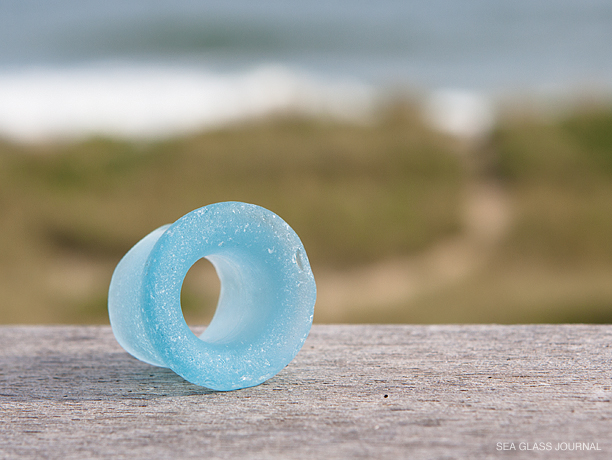
Keep up-to-date on all things sea glass... like us on Facebook!
Sea Glass Journal on Facebook





